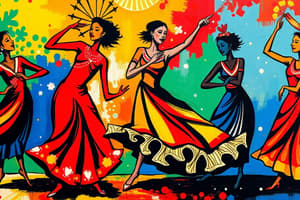Podcast
Questions and Answers
Which of the following is NOT a characteristic of national dance?
Which of the following is NOT a characteristic of national dance?
- Utilization of high-tech equipment in performances (correct)
- Diversity in unique styles across different countries
- Incorporation of traditional elements like local music
- Cultural significance reflecting a nation's heritage
What is a primary function of national dance forms?
What is a primary function of national dance forms?
- To serve as a medium for storytelling and expressing national pride (correct)
- To teach contemporary music
- To promote modern dance styles
- To enhance national political agendas
Which traditional dance form is characterized by intricate footwork, spins, and expressive gestures?
Which traditional dance form is characterized by intricate footwork, spins, and expressive gestures?
- Samba
- Kathak (correct)
- Irish Dance
- Flamenco
How does education contribute to the preservation of national dance?
How does education contribute to the preservation of national dance?
What major challenge does national dance face in today's world?
What major challenge does national dance face in today's world?
Flashcards are hidden until you start studying
Study Notes
Definition
- National Dance refers to traditional dance forms that are recognized as symbolizing a nation’s culture and heritage.
Characteristics
- Cultural Significance: Reflects the history, values, and identity of a nation.
- Traditional Elements: Often incorporates local music, costumes, and historical themes.
- Diversity: Varies widely across different countries, each with unique styles and forms.
Examples
- Irish Dance: Known for its rapid leg and foot movements while the body and arms remain still.
- Kathak: A classical Indian dance form characterized by intricate footwork, spins, and expressive gestures.
- Flamenco: A passionate Spanish dance that combines percussive footwork, hand claps, and intricate body movements.
Functions
- Cultural Expression: Serves as a medium for storytelling and expressing national pride.
- Community Bonding: Promotes social cohesion and reinforces community identity through participation in dance events and festivals.
- Tourism: Attracts visitors and showcases cultural heritage.
Preservation
- Festivals and Competitions: Events that celebrate national dance forms help maintain their relevance and popularity.
- Education: Dance schools and programs teach traditional dances to new generations.
- Documentation: Efforts to record and archive national dance forms through video and written materials.
Challenges
- Globalization: The rise of global pop culture can overshadow traditional dance forms.
- Cultural Appropriation: Issues arise when traditional dances are performed outside their cultural context without proper respect or understanding.
Conclusion
- National dance is an essential aspect of a country’s cultural identity, requiring ongoing efforts for preservation and appreciation in a rapidly changing world.
Definition
- National Dance embodies traditional dance forms standing as symbols of a nation's culture and heritage.
Characteristics
- Cultural Significance: Acts as a mirror of a nation's history, values, and identity.
- Traditional Elements: Integrates local music, costumes, and historical themes, showcasing distinct cultural traits.
- Diversity: Exhibits vast variations across countries, highlighting unique dance styles and forms integral to each culture.
Examples
- Irish Dance: Features rapid movements of the legs and feet while maintaining stillness in the upper body and arms.
- Kathak: A prominent Indian classical dance showcasing intricate footwork, spins, and expressive gestures that convey storytelling.
- Flamenco: A vibrant Spanish dance known for its expressive passion, characterized by percussive footwork, claps, and dynamic body movements.
Functions
- Cultural Expression: Functions as a platform for storytelling and conveying national pride, often during significant events.
- Community Bonding: Enhances social cohesion and strengthens community identity through engagement in dance festivals and events.
- Tourism: National dances attract visitors and display a nation’s cultural heritage, contributing to local economies.
Preservation
- Festivals and Competitions: Organized events celebrate national dance forms, ensuring they remain relevant and enjoyed by newer audiences.
- Education: Dance schools and programs are essential for teaching traditional dances to younger generations, fostering continuity.
- Documentation: Initiatives to record and archive national dance forms through audiovisual materials and written documentation aid preservation.
Challenges
- Globalization: The rising influence of global pop culture poses a threat by overshadowing traditional dance forms, leading to potential decline.
- Cultural Appropriation: Concerns emerge when traditional dances are performed outside their cultural context, often lacking proper respect or comprehension.
Conclusion
- National dance is crucial to a country's cultural identity, necessitating continuous efforts in preservation and appreciation amid a rapidly evolving cultural landscape.
Studying That Suits You
Use AI to generate personalized quizzes and flashcards to suit your learning preferences.




